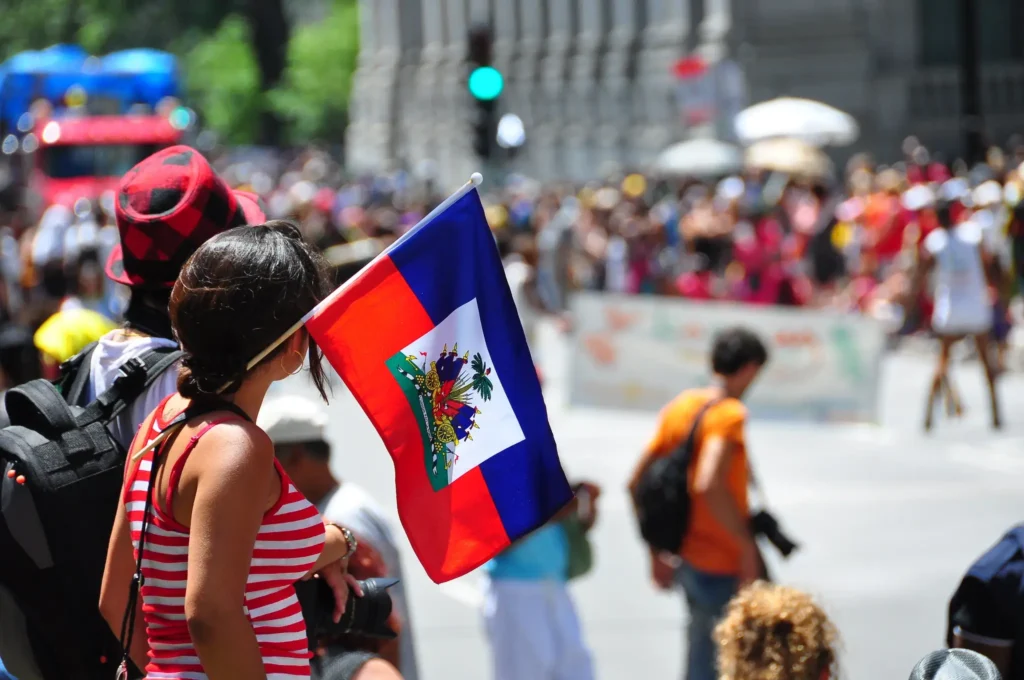The Haiti flag is more than just a national symbol. It is a powerful reminder of the long and bloody struggle for independence and unity that the Haitian people have endured. The Haiti flag’s design and colors reflect the history and culture of Haiti, as well as the aspirations and values of its citizens. In this article, we will explore how the Haitian flag represents the different phases and facets of the Haitian revolution, the first successful slave revolt in the world, and the subsequent challenges and achievements of the Haitian nation.
Haiti flag and the Haitian revolution
The Haitian flag has undergone several changes since the Haitian Revolution in 1791. Each version of the Haitian flag reflects the different phases and facets of the revolution and the Haitian people’s political and social aspirations.
The first Haitian flag was created in 1803 by Jean-Jacques Dessalines, the leader of the revolution and the first ruler of independent Haiti. He took the French tricolor flag and removed the white stripe, representing white colonists. He then sewed together the remaining blue and red stripes, symbolizing the unity of the black and mulatto Haitians. The blue represented the black population, while the red represented the gens de couleur (people of mixed race).
The second Haiti flag was adopted in 1804 after Dessalines declared himself emperor of Haiti. He added a black eagle to the center of the Haiti flag, holding a banner with the motto “Liberty or Death.” The eagle represented the strength and sovereignty of the Haitian nation, while the slogan expressed the determination of the Haitian people to fight for their freedom.
The third Haitian flag was introduced in 1806, after Dessalines was assassinated, and the country was divided into two rival states: the Kingdom of Haiti in the north, ruled by Henri Christophe, and the Republic of Haiti in the south, led by Alexandre Pétion. Christophe kept the flag of Dessalines but changed the eagle to a crowned one, signifying his royal status. Pétion, on the other hand, adopted a new Haiti flag with a blue and red horizontal bicolor and a white square in the center, containing Haiti’s coat of arms. The coat of arms featured a palm tree, a liberty cap, and various weapons, representing the Haitian people’s independence, republicanism, and defense.
The fourth Haiti flag was established in 1820 when the two states were reunited under the presidency of Jean-Pierre Boyer. He modified the flag of Pétion by changing the orientation of the blue and red stripes to vertical and adding a motto to the coat of arms: “L’Union Fait La Force” (“Unity Makes Strength”). This Haiti flag symbolized the reconciliation and solidarity of the Haitian people and their commitment to democracy and progress.
The fifth and current Haitian flag was adopted in 1986, after the fall of the Duvalier dictatorship, which had ruled Haiti since 1957. The Haiti flag restored the original design of Dessalines but with a different coat of arms in the center. The coat of arms depicts a trophy of weapons and a palm tree, surrounded by two cannons and two flags. The motto “L’Union Fait La Force” is still present, along with the country’s name: “République d’Haïti.” The Haiti flag represents the continuity and legacy of the Haitian revolution, as well as the hope and pride of the Haitian people.
Check also: How the Genderfluid Flag Represents the Diversity and Fluidity of Gender Identity.
Haitian nation’s challenges and achievements
After gaining independence, Haiti faced many challenges and achievements in its quest for development and stability. Some of the major ones are:
- Debt and isolation.
Haiti had to pay a massive indemnity to France in exchange for recognition of its sovereignty. This debt, equivalent to $21 billion today, crippled the Haitian economy for over a century. Haiti also faced diplomatic isolation and trade embargoes from many countries that feared the spread of the Haitian revolution’s ideals of abolition and equality.
- Political turmoil.
Haiti experienced frequent coups, civil wars, dictatorships, and foreign interventions that undermined its democratic institutions and human rights. Some of the most notorious rulers were François “Papa Doc” Duvalier and his son Jean-Claude “Baby Doc” Duvalier, who ruled Haiti from 1957 to 1986 with the support of a brutal paramilitary force known as the Tontons Macoutes. The Duvaliers enriched themselves and their allies while impoverishing and repressing the majority of the population.
- Natural disasters.
Haiti is vulnerable to hurricanes, earthquakes, floods, landslides, and droughts that have caused widespread damage and loss of life. The most devastating one was the 2010 earthquake that killed over 200,000 people and displaced 1.5 million more. The quake also triggered a cholera outbreak that infected over 800,000 people and killed over 10,000. The recovery efforts were hampered by corruption, mismanagement, and lack of coordination among the international aid agencies and the Haitian government.
- Social movements.
Despite the hardships, the Haitian people have shown resilience and courage in fighting for their rights and dignity. Some of the notable social movements in Haiti’s history are the peasant uprising of 1946 that led to the end of the U.S. occupation; the democratic movement of 1986 that toppled the Duvalier regime; the Lavalas movement of 1990 that elected Jean-Bertrand Aristide, the first democratically elected president in Haiti’s history; and the PetroCaribe movement of 2018 that demanded accountability for the alleged embezzlement of $2 billion from a Venezuelan oil subsidy program.
- Cultural richness.
Haiti has a vibrant and diverse culture that reflects its African, European, Indigenous, and Caribbean influences. Haiti is known for its art, music, literature, cuisine, religion, and folklore. Some of the famous Haitian cultural icons are painter Hector Hyppolite, who blended Vodou and modernist styles; singer and activist Emeline Michel, who is considered the “Queen of Haitian Song”; novelist Edwidge Danticat, who writes about the Haitian diaspora and the legacy of trauma; chef José Andrés, who founded the World Central Kitchen, a nonprofit organization that provides meals to disaster victims; and priestess Marie Laveau, who was a leader of the Vodou community in New Orleans.
Conclusion
The Haiti flag is a testament to the courage and resilience of the Haitian people, who have fought for their independence and unity against all odds. The Haiti flag’s colors and symbols reflect the history and culture of Haiti, as well as the challenges and achievements of the Haitian nation. The Haiti flag also inspires the Haitian diaspora and the world to uphold the values of freedom, equality, and solidarity that the Haitian revolution embodied. The Haitian flag is a national emblem and a global icon of hope and dignity.







